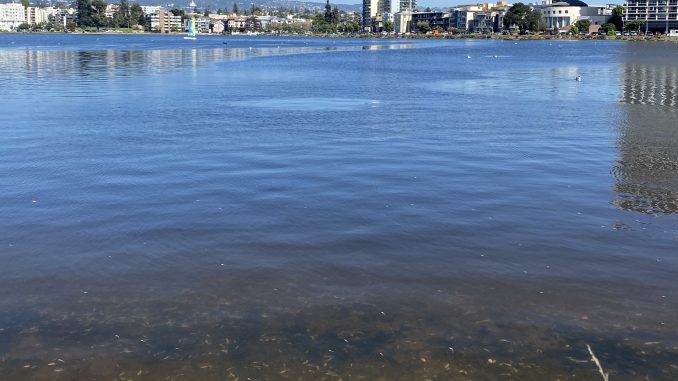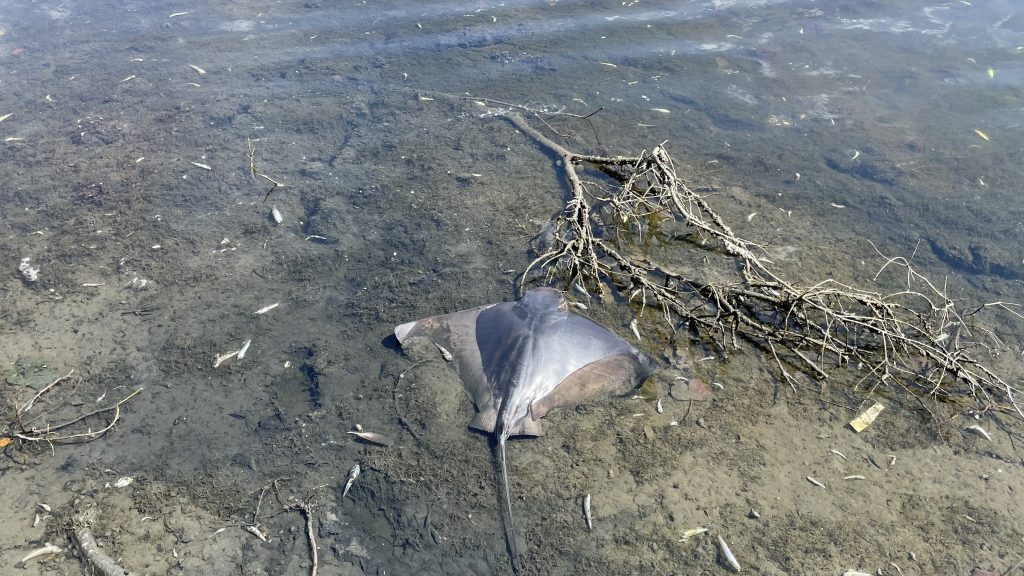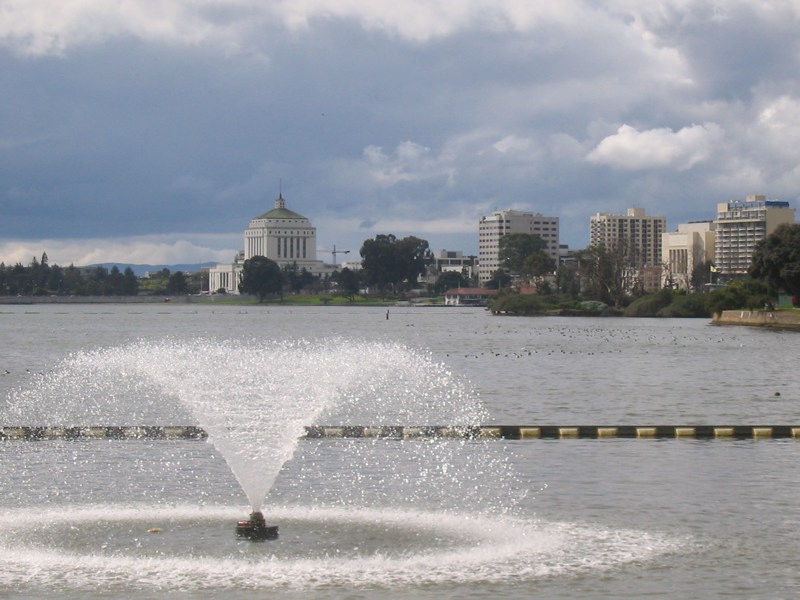
Yesterday, Lake Merritt and nature enthusiasts were alarmed to find tens of thousands of dead fish and other marine life along the edges of the lake.
Among the dead wildlife were smelt, striped bass, bat rays, gobies, halibut, mussels, and marine worms.
Oakland resident and host of KPFA’s Letters & Politics radio show Mitch Jeserich said he’s been going to Lake Merritt nearly every day since the pandemic for “some wonder and nature and awe.” He noted that Lake Merritt is the oldest wildlife refuge in North America, and “to have that right in a city environment is pretty special.”
But on Sunday, Jeserich encountered a nearly-apocalyptic sight he’d never imagined. “All of a sudden one day, yesterday, there’s just nothing but death everywhere—thousands of dead fish everywhere,” he told Oakland Voices.
“It’s like watching a forest burn down,” said Damon Tighe, a citizen scientist who has been tracking the wildlife at the lake for 20 years.
The likely culprit of the massive die-off is a harmful algal bloom, which has been occurring for weeks in the nearby areas, including at the lake, in Alameda, and beyond. The algae, Heterosigma akashiwo, is naturally occurring in the water but can cause a “red tide” when the algae takes over an area, creating a brown rust color.
“Given everything we’ve been observing and the major bloom event that made its way into Lake Merritt, it’s reasonable to suspect that it is from the bloom that caused it,” said David Senn, Senior Scientist at the San Francisco Estuary Institute, a nonprofit using science to improve the waters of the San Francisco Bay, the California Delta, and more.
The red tide depletes dissolved oxygen in the water, and kills off fish. A bloom of this magnitude hasn’t been seen in this area since 2004, according to San Francisco Baykeeper, a nonprofit aimed at protecting the Bay and the watershed.

So on Sunday and Monday, at certain parts of the lake, dead marine animals could be seen. Some note that the travesty is that Lake Merritt’s wildlife has been rebounding after the passage of the city’s bond Measure DD in 2002. “We had salmon come back last year,” Tighe said.
Tighe notes that it’s not only the visible deaths such as fish and bat rays, but the smaller marine life such as the polychaetes, or marine worms, and bivalves such as clams and mussels, that are lower on the food chain. Beyond Lake Merritt, he noted that “hundreds of marine worms are dead along the MLK shoreline,” creating a potential “ripple effect into the ecosystem.”
Tighe believes more than 39 bat rays have died inside the lake since the algal bloom.
Some may be surprised to learn that Lake Merritt is actually home to so much marine wildlife.
The lake is connected to the Oakland Estuary and San Francisco Bay via the Lake Merritt Channel. The flood control station on 7th Street in Oakland has approximately four-inch wide bars that allows small fish and even larger animals to go in and out of the lake, according to James Robinson, Executive Director of the Lake Merritt Institute, a nonprofit founded in 1992 focusing on educating the public about urban runoff keeping the lake clean.
That means striped bass, halibut, bat rays, and crabs may come inside the lake to feed off of worms, mussels, smaller crustaceans, or fish. “They definitely come in looking for something to eat,” Robinson said.
According to the Lake Merritt Institute, 30 species of fish and 140 species of birds live inside the lake, as well as “marine life such as sponges, shrimp, clams, mussels, tubeworms, a few crabs, barnacles, hydroids, marine snails and other invertebrates.”
Robinson said that these types of fish and other animals are present at the Lake regardless of the algal bloom. “A lot of times people don’t know because it doesn’t look like anything’s there.”
The toxic bloom is also concern for pets and people who ingest foods such as shellfish, and scientists have also cautioned against swimming inside the Bay.
“Baykeeper cautions against people or pets contacting the brown murky water, or eating fish, and particularly shellfish, caught in the area, until the algal bloom dissipates,” according to a statement by San Francisco Baykeeper Executive Director Sejal Choksi-Chugh.
The algal bloom is occurring in different parts of the San Francisco Bay. There have also been reports of dead sturgeon and other fish around the Bay.
If there is any solace, it is that perhaps this wave of algal bloom may be over at the lake.
Both the fish and the algae are competing for oxygen, so when there is massive deaths of fish, it could mean that the algal bloom is also ending, according to Robinson. “Usually, the fish will die off and the red tide will dissipate as well. Today, I was walking around….The color of the water has changed back to its normal color, rather than the brownish or reddish color usually when red tide is present.”
Tighe said that because the water is clearer as of Monday, that it is a sign that the algae bloom has also died off and sunk to the bottom. However, there’s also a chance that while the algae bloom may be over this time in the lake, that it could come back.
As for the types of marine animals, Tighe and others are hopeful that they will return at some point. But, there could be less birds, since the birds feed on the marine life that have died.
“I think it’ll bounce back, but I don’t know how long it’ll take,” Tighe said.
For now, he said that it’s important for people around the Bay Area to document what they see using a citizen naturalist app called iNaturalist, where people upload photos and other users can help identify plants or animals, for example. Tighe has made more than 70,000 observations and documented 10,000 species on the app, and said that it’s an important tool to track an event such as the algal bloom. Otherwise, it’s “hard to understand the magnitude” of what’s happening.
Momo Chang is a freelance journalist based in the San Francisco Bay Area. She is the Oakland Voices Co-Director. Her work focuses on healthcare, immigration, education, Asian American communities, food and culture. She is a former staff writer at the Oakland Tribune. Momo has received journalism awards from the Society of Professional Journalists for investigative reporting and the Asian American Journalists Association, among others. Her work has appeared in the East Bay Express, San Francisco Chronicle, Wired, and The New York Times. Momo is primarily a print journalist who also produces audio and visual stories for documentary film and radio. She is a Senior Contributing Editor for Hyphen and formerly the Content Manager at the Center for Asian American Media (CAAM).




1 Trackback / Pingback